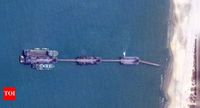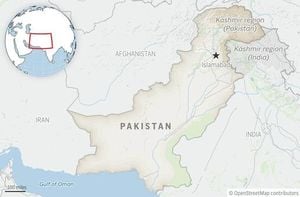Recent satellite images from Google Maps have captured what appears to be a significant military development in China, revealing at least six nuclear-powered submarines docked at the First Submarine Base near Qingdao. This location, situated about 18 kilometers east of Qingdao in the Yellow Sea, raises alarms about Beijing's growing military capabilities and intentions in the region.
According to a report from The Sun, the images were shared by Australian naval analyst Alex Luck, who identified two Type 091 submarines, two Type 093A submarines, and one unidentified vessel. Notably, Luck also highlighted the presence of the Type 092 ballistic missile submarine, which until recently was China's only ballistic missile submarine.
In a related development, Taiwan's Ministry of National Defence (MND) reported a sharp increase in Chinese military activity around its airspace and waters on April 17, 2025. The MND detected 34 aircraft from the People's Liberation Army (PLA), alongside six naval vessels from the People's Liberation Army Navy (PLAN) and two official ships, all operating in the vicinity of Taiwan until 6 am local time.
In response to the escalating tensions, Taiwan has initiated a two-week military simulation designed to prepare for a potential all-out Chinese assault. The annual Han Kuang exercises will simulate various scenarios, including grey zone attacks and a full-scale invasion projected for 2027, utilizing U.S.-built simulation tools. Live-fire drills are also anticipated in July 2025.
While Taiwan has governed itself since 1949, the Chinese government views the island as a part of its territory. Under the "One China" policy, Beijing continues to assert its claim over Taiwan and has not excluded the option of using force to assert control.
In another geopolitical twist, the Chinese Embassy in the Philippines lodged a formal protest on April 17, 2025, against Google Maps' decision to label parts of the South China Sea as the "West Philippine Sea." This change, which allows users to see the label without needing to search for it, has sparked significant concern from Chinese officials, as highlighted by spokesperson Lin Jian on April 16.
Lin emphasized that the term "South China Sea" has long been recognized by the international community, including the United Nations, and argued that Google's alteration contradicts established international conventions. He maintained that such changes would not affect China's sovereignty or maritime rights in the region.
Previously, users had to specifically search for "West Philippine Sea" to view that designation on Google Maps. However, the updated map now directly identifies waters near the Philippines as the "West Philippine Sea," including the disputed Scarborough Shoal. Areas to the north and west remain marked as the South China Sea.
The Philippines has used the term "West Philippine Sea" since 2011 to assert its maritime claims within its exclusive economic zone (EEZ), distinguishing its claims from China's broader assertions over the South China Sea. The Speaker of the Philippines House of Representatives, Martin Romualdez, welcomed the update, stating, "The proper and consistent labeling of the West Philippine Sea on the widely used platform Google Maps is welcome news for every Filipino. This simple yet powerful update reflects the growing global acknowledgment of the Philippines’ sovereign rights over the maritime areas within our EEZ."
Col. Francel Margareth Padilla, spokesperson for the Armed Forces of the Philippines, echoed this sentiment, stating that the inclusion of the West Philippine Sea in Google Maps aligns with a 2016 arbitration ruling that invalidated China’s expansive claims over the South China Sea.
China's foreign ministry reiterated that the South China Sea is widely recognized as the correct name by other nations. Lin Jian pointed out that the name has been a common geographical designation accepted by the international community, including various international organizations.
Furthermore, Ding Duo, a researcher at China’s National Institute for South China Sea Studies, downplayed the significance of the term "West Philippine Sea," asserting that it does nothing to alter China's claim of "indisputable sovereignty" over the South China Sea islands.
The motivations behind Google's decision to update the map label remain unclear. A spokesperson for the company stated, "The West Philippine Sea has always been labeled on Google Maps. We recently made this label easier to see at additional zoom levels."
Despite a 2016 Hague tribunal ruling that sided with the Philippines and invalidated China's claims, Beijing has continued to assert control over the region, which is vital for international shipping. Tensions have escalated as both nations have accused each other of dangerous maneuvers near the Scarborough Shoal, a disputed area within the Philippines’ EEZ.
The Philippine Coast Guard reported incidents of a Chinese vessel obstructing a Philippine ship, while China claimed that the Philippine vessel approached dangerously, attempting to provoke a collision. Additionally, the Philippines has raised alarms over Chinese interference in resource exploration in the contested waters, citing incidents of harassment, including water cannoning and the use of lasers.
In light of these challenges, the Philippines has bolstered its military cooperation with the United States. The annual "Balikatan" joint military exercises, involving approximately 14,000 troops, are scheduled from April 21 to May 9, 2025. These exercises aim to enhance defense readiness and interoperability between the two allies, underscoring the growing concern over regional security.
As tensions continue to rise in the South China Sea and around Taiwan, these developments signal a critical juncture in geopolitics, with implications for international relations in the Asia-Pacific region.






